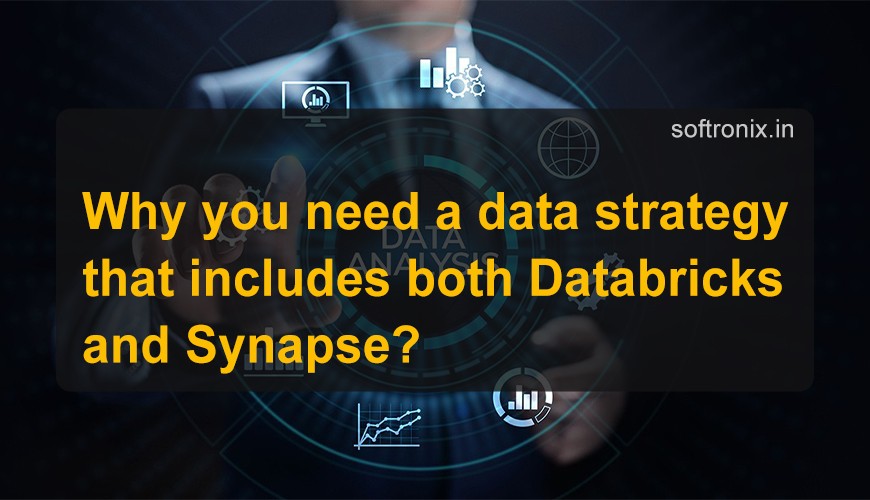
Why you need a data strategy that includes both Databricks and Synapse?
In today’s digitally evolving environment, organizations continue to understand the significance of a robust data system. As more and more data is produced every second, it becomes critical to have appropriate technology and methodologies to leverage this data. Two prominent leaders that have appeared in this sphere are Databricks and Azure Synapse Analytics. Both approaches have their benefits that enable optimizing the organization’s data, depending on the prioritized objectives, and their integration can make a huge leap in terms of the organization’s data capabilities. Here is why both have to be taken into consideration.
Understanding the Platforms:
Databricks
Databricks is a cloud-based data processing tool suitable for big data and follows the provision of advanced data analytics. It is constructed on Apache Spark which holds the capability for multiple users to work together, data engineering, machine learning, and data science all under one platform. As we have discovered earlier, Databricks is renowned for its capabilities to work with big data with high velocity and scale effectively, thus it is a go-to choice for organizations interested in big data analysis and artificial intelligence.
Importance of Databricks
Databricks are vital in the contemporary data planning since it offers a joined working environment for large data examinations and artificial intelligence operations. Based on Apache Spark, it enables an organization to process a large amount of data within a specific time frame to create real-time, and advanced analysis. It has a well-designed, shared team environment that minimizes barriers to communication between practitioners in the data science, data engineer, and business analyst roles.
Azure Synapse Analytics
Azure Synapse Analytics also previously known as Azure SQL Data Warehouse can be described as a complex analytics service that embodies both big data and data warehousing. It enables querying of data using AWS services such as serverless or provisioned services, as well as other services, like Azure Data Lake Storage, and Power BI. Synapse comes with instruments for data ingestion, management and visualization, real-time, and batch to qualify it for BI and DW.
Importance of Synapse
Most organizations need Azure Synapse Analytics due to issues experienced when using Traditional data warehouses and Big data warehouses. As a single platform for big data and data warehousing solutions, Synapse makes it easy for users to process large amounts of structured as well as unstructured data. Its querying strength is endowed with specialized serverless and provisioned resource characteristics to suit multiple analysis demands.
The Case for Integration
Although Databricks and Azure Synapse are strong platforms of their own, synergistically, they can create comprehensive solutions for data planning. Here are several reasons why integrating both platforms is beneficial:
1. Different Data Processing Skills
Databricks can be used to control stream data and batch processing to provide analytics in real-time. On the other hand, it is quite exceptional at data warehousing and other complex queries. Both are useful in that it becomes possible for an organization to process all types of data in a seamless manner, which makes for better analysis.
2. Enhanced Collaboration
Databricks also supports both data scientists and data engineers with its notebooks, as well as data analysts in its development environment. What it means is that when Synapse is integrated into teams, people can work, share, and build solutions within workflows. This change also erases barriers between employees from different departments, as well as increases efficiency.
3. Seamless Data Integration
While both platforms can operate with progressive compatibility with different data streams, the total of both might offer a better continuity of flow of data. Databricks can be used to clean and transform the data and this data can be stored and queried for reporting and analysis on Synapse. This integration helps avoid the situation where data is obtained and stored only to be used extremely rarely.
4. Big Data and Business Intelligence
Databricks is especially well-suited for machine learning as OS: it consists of ML libraries and frameworks, for instance, MLflow for model tracking and deployment. When used in conjunction with Synapse, organizations can set up an environment where further analytics can have an immediate impact on the business. In Databricks, you can both train and deploy your models as well as rely on Synapse for generating impressive business intelligence dashboards.
5. Cost-Effectiveness
It also means that using both platforms can bring more cost-effective solutions than using any of them separately. For instance, while Databricks can work out deep data computations, Synapse can provide economical storage of the data. This division of labor assists organizations in managing their resources and financial resources well.
Conclusion
Adopting both Databricks and Azure Synapse Analytics as key data management tools is neither a trend nor an option but a necessity. Hence, by integrating the strengths of such platforms organizations can improve the processing of data, encourage collaboration, and consequently, improve the business result.
Embrace the power of both platforms and watch your data strategy flourish with Softronix - IT Training Institute. Get started today!

0 comments